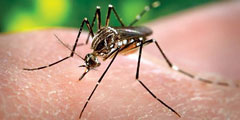 |
Billions of people around the world are at risk from bacteria and viruses transmitted by mosquitoes, ticks, fleas and other vectors. Vector-borne infection results in some of the world’s most destructive diseases—many of which have emerged as increasing threats to human health in this age of globalization.
Meet the Vectors
Vector-borne diseases are especially difficult to prevent, predict and control. Only a few have vaccines. Additionally, almost all vector-borne pathogens are zoonoses, meaning they can live in animals as well as in humans. An arbovirus is defined as any of a group of viruses that are transmitted by arthropods such as mosquitoes and ticks—which are notoriously difficult to reach, physically, and often develop resistance to insecticides. The most widely known vector-borne diseases in the United States are Lyme disease, West Nile virus (WNV) and Rocky Mountain spotted fever.1
 |
| The Aedes species of mosquito is a vector for several diseases. |
Mosquitoes. Numerous species of mosquitoes feed on the blood of various types of hosts, mainly vertebrates, including mammals, birds, reptiles and amphibians. Mosquito-transmitted infection causes millions of deaths worldwide every year. Zika virus, dengue fever, chikungunya virus, yellow fever, malaria and WNV are just some of the life-threatening diseases associated with mosquitoes.2 Species within the Aedes genus (primarily Ae. aegypti and Ae. albopictus) carry several of these diseases (Table 1).
As global travel and changing land use increase, the risk of rare or new vector-borne pathogens emerging and crossing borders also increases.
West Nile Virus
WNV, which was unknown in the United States before 1999, infected 5,674 Americans in 2012.1,3 Now, WNV is one the most important mosquito-transmitted viruses native to the United States. It is a seasonal epidemic in North America, usually flaring up during the summer until the first frost.
Table 1. Diseases Transmitted by Aedes Mosquitoes1,2
|
WNV causes life-threatening complications in approximately 1% of infected persons, with increased morbidity and mortality in individuals older than 50.1,3 Neurologic sequelae include severe muscle weakness, with approximately 10% of patients developing a complete flaccid paralysis.3
Reported types of WNV-related ophthalmic involvement are listed in Table 2.3 Most ocular signs may be treated with a topical and/or systemic steroid, but seem to be self-limited in the majority of cases. Prognosis of ophthalmic complications in WNV is generally favorable. In rare instances, ocular involvement has led to a permanent decrease in acuity and visual fields.
Dengue
Globally speaking, dengue is the most common arboviral disease, with 40% of the world’s population living in areas with known dengue virus transmission.4 Dengue is typically a self-limiting disease with an overall mortality rate of less than 1%.1,4 A small percentage of patients previously infected by one dengue serotype develop bleeding and vascular endothelial leakage upon infection with a second dengue serotype. This very serious syndrome is known as severe dengue or dengue hemorrhagic fever.
Zika and the 2016 Summer OlympicsBrazil is the epicenter of Zika. The World Health Organization (WHO) has declared Zika virus a global health emergency. There has been considerable debate, even among medical experts, about whether Rio de Janeiro adequately addressed the issue for the 2016 Olympics. Several high profile athletes, including top ranked golfers Jason Day and Rory McIlroy, cited fear of Zika as the primary reason for deciding not to participate in the games. WHO issued guidelines for athletes as well as others who were in Brazil for the Olympics and Paralympics. The recommendations included using insect repellent, practicing safer sex or abstinence and staying home if pregnant. The official statement is available at www.who.int/mediacentre/news/statements/2016/zika-olympics/en/. |
Reported types of dengue-related ophthalmic involvement are listed in Table 2. Most patients with visual symptoms and signs recover spontaneously without any treatment. Patients with severe vision loss or bilateral involvement have been successfully treated with systemic steroids and occasionally immunoglobulins.4 Prognosis of dengue-related ophthalmic complications is generally favorable.
The case-fatality rate of patients with severe dengue varies with the timing and quality of clinical care. When treated, dengue hemorrhagic fever has a mortality rate of 2% to 5%, but when left untreated, the mortality rate is as high as 50%.1,4 Dengue virus has emerged as a major health problem in Puerto Rico.
Surveillance, Protection, Detection, Action
The CDC Division of Vector-Borne Diseases (DVBD) strives to protect our nation from diseases transmitted by mosquitoes, ticks and fleas. Some of these diseases have long been present in the United States while others have emerged more recently. The DVBD plays a unique role, housing much of the world’s expertise in the diagnosis, prevention and control of these diseases.5 A major part of the DVBD’s ongoing work is disease tracking, laboratory studies, education and technical assistance and response. The DVBD also deals with the increasing problem of travel-associated infections and the threat of exotic arbovirus importation.
Table 2. Ophthalmic Significance of Aedes-involved Infection1-4 | |
West Nile Virus
Dengue
| Zika Virus
Infants with microcephaly
|
The CDC developed and leads ArboNET, the national surveillance system that monitors mosquito-borne infections in humans, birds and other animals. This information allows the CDC and its partners in local and state health departments, other government agencies and private industry to prepare for and quickly respond to epidemics.6 Early detection and intervention is critical for making sound decisions about the need for insecticide spraying and other protective community interventions.
Zika Virus
Our next article will be a detailed review of Zika virus. Zika-infected babies with microcephaly are at risk for potential ocular complications listed in Table 2. Infected adults have presented with clinical signs of uveitis and conjunctivitis.2,7,8
|
1. World Health Organization. Vector-borne diseases. Available at www.who.int/mediacentre/factsheets/fs387/en/. Accessed August 8, 2016. 2. Hennessey M, Fischer M, Staples JE. Zika virus spreads to new areas—region of the Americas, May 2015–January 2016. Am J Transplantation. 2016;16(3):1031-4. 3. Priestley Y, Thiel M, and Koevary SB. Systemic and ophthalmic manifestations of West Nile Virus infection. Expert Rev Ophthalmol. 2008;3(3):279-292. 4. Ng AW and Teoh SC. Dengue eye disease. Survey of Ophthalmology. 2015;60(2):106-14. 5. Centers for Disease Control and Prevention National Center for Emerging and Zoonotic Infectious Diseases (NCEZID). Division of Vector-Borne Diseases (DVBD) Fact sheet. Available at www.cdc.gov/ncezid/dvbd/pdf/dvbd_factsheet.pdf. Accessed August 4, 2016. 6. Meissner HC. Fragile but potentially deadly: Mosquitoes transmit illnesses to millions every year. AAP News. June 28, 2016. 7. Kindhauser MK, Allena T, Franka V, et al. Zika: the origin and spread of a mosquito-borne virus. Bull World Health Organ. 2016:171082. [Epub]. 8. de Miranda HA, Costa MC, Frazão MAM, et al. Expanded Spectrum of Congenital Ocular Findings in Microcephaly with Presumed Zika Infection. Ophthalmology. 2016;123(8):1788-94. |


